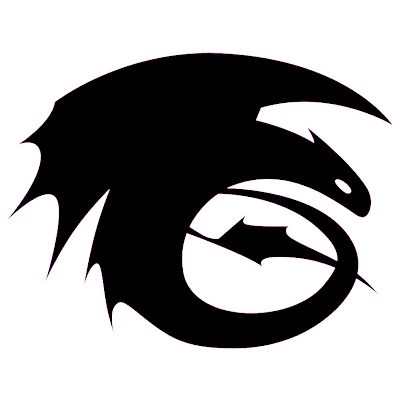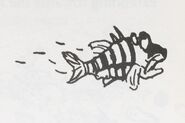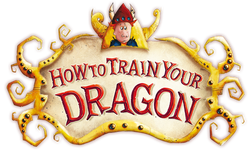|
Fish are a large grouping of animals mentioned often in the How to Train Your Dragon Book series, but mainly are relegated to background positions with in the stories.
Description[]
Taxonomically, there is no one taxa for Fish. Classically fish were ordered in Class Pisces. However, with increased technology and findings, creatures generally called 'fish' are not actually closely related or derived from the same ancestor. Currently, a Fish is defined as a creature with a skull, does not have legs, has gills through its whole life, and has fins (if any limbs at all). Fish also rely to some extent on aquatic environments. Most fish must stay in water to live. Some species may be able to spend a period of time out of water and survive. Other than these particular points, fish as a group is very diverse in morphology, diet, behavior, environment, and reproduction.
Function[]
In both the Book series and in real life, the main function for humans of fish are as a food source. In the Book series, they are also a food source for Dragons. In the Book series, fish may also appear as the subject of artwork, and also as a metaphor for describing other things or phrases for exclamation.
Types of Fish seen in the Book Series[]
Flounder[]
In How to Cheat a Dragon's Curse, Hiccup tries to not get caught in the Hysteric Great Hall during a Freya'sday Eve feast. He throws food at the Hysterics, including "slapping another opponent around the cheek with a large flat flounder".
Flounders are a grouping of Flatfish found in various regions around the world. They stay on the bottom of marine waters and have adapted by becoming flat and their eyes migrate to one side of their bodies as they grow. Historical Vikings may have encountered the European flounder (Platichthys flesus) in their travels and fishing activities.
Flying Fish[]
Flying Fish are mentioned in the Children's book, Hiccup: The Viking Who Was Seasick. A very young Hiccup steers a lost Viking ship home, past many wondrous creatures such as flying fish.
Flying fish (Family Exocoetidae) are fish living in tropical and sub-tropical waters worldwide. They have extremely long pectoral fins which allow them to jump from the water and glide in the air, giving the appearance of flight.
Haddock[]
Haddock (Melanogrammus aeglefinus) are a North Atlantic fish that is a well-known species for human consumption. It is also known for the black lateral line on its side and a 'thumb-print' mark just above its pectoral fin. Norwegians have a dish of fish balls called "fiskeboller" that is made predominantly of haddock.
Haddock are mentioned briefly, but often, in the Book series, as a descriptor.
| “ | It was the stench of DEATH itself - a deep, head-spinning stench of decaying matter; of rotting haddock heads and sweating whale; of long-dead shark and despairing souls. | ” |
| — Breath of the Green Death in Book 1 |
| “ | To the nose of an aristocrat like myself," she hissed, "the thing was reeking like a week-old haddock. | ” |
| — Fireworm, discussing the treasure she sniffed out in Book 2 |
Ziggerastica the King Nanodragon, employs colorful language to describe humans in How to Speak Dragonese.
| “ | Well, Boy-With-a-Face-like-a-Stinky Haddock ... | ” |
| — Ziggerastica to Hiccup in Book 3 |
| “ | But what about the one with the face like a haddock? | ” |
| — First Kidnapper referring to Fishlegs, speaking in Latin, from Book 3 |
| “ | Is Fisheggs your odd little friend with the face like a depressed haddock? | ” |
| — Stoick to Hiccup in Book 4 |
Haddock are also mentioned being consumed by Vikings, even as a part of breakfast. In Hiccup: The Viking Who was Seasick, Hiccup mentions having "two smallish haddock for breakfast", while Stoick later mentions having "thirty-seven largish haddock" for breakfast that same morning.
In How to Be a Pirate, Hiccup tries to get Toothless out of the house to practice sniffing for treasure. He uses food to tempt him, including a mackerel "as well a small haddock pie and three or four oysters."
Herring[]
Herring are mentioned in How to Train Your Dragon when Hiccup feeds Toothless kippers. Kippers are herring that are split lengthwise, preserved (salted or pickled), and then smoked.
| “ | ... Toothless returned from a second trip, clearly too bored for words but dropping a couple of herring at Hiccup's feet. | ” |
| — During the Initiation Test in Book 1 |
| “ | Why not just feed him [the Green Death] fried herring and see whether he drops dead of a heart attack in twenty years or so? | ” |
| — Snotlout taunting Hiccup's plan in Book 1 |
Kippers are mentioned again in How to Speak Dragonese, when the author mentions that Hiccup "would have been as dead as a kipper several books ago" if he had been a "traditional Hooligan Hero". Hiccup also has kipper for breakfast at his home later in the Book.
| “ | A noble kipper, perhaps, a gloriously brave kipper, but, nonetheless, a very, very dead kipper. | ” |
| — Book 3 |

In the Dragon Jewel Map, there is a picture of a red herring, which is a sign that the Dragon Jewel is not there.
Lemon Sole[]
Ziggerastica mentions lemon sole during one of his condescending speeches about the appearance of Hiccup and his friends in How to Speak Dragonese.
| “ | By the way, O-Boy-With-a-Nose-Like-a-Small-Potato, your friends are even uglier than you are! Where did you find these people? Never in my life have I seen anybody who looks so much like a lemon sole ... | ” |
| — Ziggerastica in Book 3 |
The lemon sole (Microstomus kitt) is a fish native to shallow seas and oceanic coastlines in Scandinavia. It is a type of flatfish with eyes migrating to the right side of its head at maturity.
Mackerel[]
Mackerel are mentioned in the first book when describing the smell of dragons. The Dragon Nursery is described as smelling of "the stench of dragon - a salty stink of seaweed and old mackerel heads", in Book 1.
Mackerel are also eaten by Vikings and Dragons, and are a common fishing target for dragons.
| “ | If you catch me a nice big mackerel you will be the cleverest, fastest dragon on Berk AND you will make that Fireworm dragon look like an idiot AND you will have all the lobsters you can eat when we get home AND I will tell you a really good joke. | ” |
| — Hiccup to Toothless in Dragonese in Book 1 |
| “ | Hiccup had gotten bored and was looking for oysters when Toothless came bursting triumphantly out of the sea carrying a small mackerel. | ” |
| — Book 1 |
| “ | But he [Toothless] came back when Hiccup called, eventually, and by the end of a couple of hours he had caught six medium-sized mackerel and a dogfish | ” |
| — Book 1 |
Stoick the Vast eats a whole mackerel for breakfast in How to Cheat a Dragon's Curse.
Mackeral is mentioned again in How to Be a Pirate, when Hiccup tries to cajole Toothless from his house with one, to practice treasure-sniffing outside.
During an 'Advanced Rudery' lesion in How to Be a Pirate, Snotlout spars with Tuffnut Junior at hurling insults.
| “ | You ... are a cowardly cowering cuttlefish ... with the heart of a jellyfish, the brains of a plankton, and the stink of a barrelful of mackerel heads. | ” |
| — Snotlout to Tuffnut Junior in Book 2 |
Mackerel are mentioned again in How to Be a Pirate when Toothless catches "a couple of nice plump mackerel on the way" back to Berk from the Isle of the Skullions.
Toothless expresses astonishment at the behaviors of humans in How to Speak Dragonese, using mackerel.
| “ | You V-v-Vikings are as m-m-mad as mackerel. | ” |
| — Toothless in Book 3 |
In How to Cheat a Dragon's Curse, Hiccup sees a group of mackerel underneath the ice in the Wrath of Thor while traveling across it to Hysteria.
| “ | I can even make out a shoal of mackerel down there ... The mass if tiny fish went on forever, swimming slowly in their millions way down below them ... | ” |
| — Hiccup's thoughts in Book 4 |
Mackerel as food for humans is mentioned later in Book 4. Deep-fried mackerel appears as a dish at a huge feast on Freya'sday Eve in the Hysteric Great Hall. Camicazi later describes the Hysterics themselves as being "made as mackerel".
Mudskipper[]
| “ | His [Hiccup] heart started jumping like a mudskipper as he looked into the terrible face of the man who had Stoick the Vast by the throat. | ” |
| — Book 2 |
The Mudskipper's jumping ability is mentioned in How to Be a Pirate, describing Hiccup's beating heart. Mudskippers (Subfamily Oxudercinae) are strange fish that do jump or "skip" around on land. They are able to walk well on their pectoral fins and not only breathe in water through their gills as other fish, but also through their skin and oral mucosa. They typically inhabit tidal pools and shallow water and stay out of the water when the tides move out.
Piranha[]
Piranha are mentioned in Book 1 when Gobber describes what will happen if the Viking Novices wake up the dragons hibernating in the Dragon Nursery.
| “ | Dragons this size are normally fairly harmless to man, but in these numbers they will set upon you like piranhas. There'd be nothing left of even a fatso like you, Wartihog - just a pile of bones and your helmet. | ” |
| — Gobber |
Piranha are also mentioned in Book 4 when describing Squealer dragons, slug-like sedentary creatures who will devour anything.
| “ | The Squealers then devour their victim, and rather like piranha fish, they can strip an animal to the bone in sixty seconds flat. | ” |
| — Book 4 |
Piranha are a Family of South American freshwater fish which are omnivorous. They have the most powerful bit of a bony fish and teeth so sharp that they have been used as tools for carving wood and other uses. Stories exist of piranha stripping an animal down to the bones. While capable of this, piranha typically do not have this behavior. Most human-piranha interactions results in a bite or two, usually to the feet.
Seahorse[]
Seahorses are mentioned in "How to Be a Pirate", as decoration on cups in the treasure hoard of Grimbeard the Ghastly.
| “ | Gorgeous silver cups with seahorses galloping delicately around them and golden necklaces as plump as oysters and swords as sharp as a conger's tooth with octopus tentacles winding themselves around the hilt. | ” |
| — Book 2 |
Seahorses (Genus Hippocampus) are a strange type of fish the swims upright and whose appearance mimics the head and neck of a horse. They are found in tropical waters around the world. Seahorse males are the ones who incubate and hatch the eggs, after a female mate deposits them in a specialized brooding pouch.
Shark[]
See the page Shark for more information.
Swordfish[]
| “ | Well, suffering swordfish," exclaimed Fishlegs. "Hiccup is LEFT-HANDED. | ” |
| — Fishlegs in Book 2 |
Swordfish are used as an exclamative phrase in the How to Train Your Dragon Books.
In real life, Swordfish (Xiphias gladius) are temperate and tropical ocean fish that are fished as food and for sport. Adult swordfish have very few predators other than humans. Occasionally some sharks or killer whales will prey on adult swordfish.
Tuna[]
Tuna is mentioned as an edible fish in the first Book, How to Train Your Dragon. In reality, Vikings would have only encountered a tuna fish possibly during trading and raids to Southern Europe. Tuna species prefer temperate to tropical waters. "True Tuna" (Genus Thunnus) include species such as Albacore, Atlantic Bluefin, and Bigeye.
| “ | Hiccup could not eat a thing, and more, unusually, could Toothless, who was in a difficult mood and turned his nose up at the tuna sandwich Valhallarama offered. | ” |
| — Book 1 |
Appearances[]
| Main Series | ||||||||||||
| "How to Train Your Dragon": | Appears | "How to Ride a Dragon's Storm": | Absent | |||||||||
| "How to Be a Pirate": | Appears | "How to Break a Dragon's Heart": | Absent | |||||||||
| "How to Speak Dragonese": | Appears | "How to Steal a Dragon's Sword": | Absent | |||||||||
| "How to Cheat a Dragon's Curse": | Appears | "How to Seize a Dragon's Jewel": | Absent | |||||||||
| "How to Twist a Dragon's Tale": | Absent | "How to Betray a Dragon's Hero": | Absent | |||||||||
| "A Hero's Guide to Deadly Dragons": | Absent | "How to Fight a Dragon's Fury": | Absent | |||||||||

















